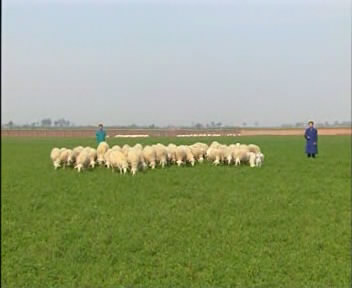Six new techniques for raising sheep
Sheep industry is gradually shifting from sheep raising in pastoral areas to agricultural areas. However, the traditional extensive management in rural areas is difficult to obtain great economic benefits. Combined with the introduction of excellent varieties, vigorously promote the following six new technologies that are easy to operate and master, which can greatly improve the economic benefits of raising sheep.

Sheep raising 1. The popularization of artificial insemination can greatly improve the utilization rate of breeding sheep, reduce the breeding quantity of male sheep, and save the feeding cost and the purchase cost of fine breeding ram. Moreover, the price of good breeding ram is expensive, and at present, each ram is more than 10,000 yuan. If the breeding method is adopted, it is easy to lead to cross-infection and spread of some diseases, which makes the breeding ram lose its breeding ability and the basic ewe lose its breeding value. Second, after supplementary feeding and early weaning lambs reach several weeks of age, ewe milk can no longer meet their nutritional needs, so it is necessary to train lambs to eat grass and feed in the early stage. Generally, the lambs were induced to eat at the age of 10 days, fed with 70g at the age of 15-30, 100g at the age of 60m and 200g at the age of 90d, so as to ensure the lamb to be strong and grow rapidly, laying a good foundation for early weaning and fattening in the later stage. Early weaning is carried out at the age of 100 days, not more than 4 months at the latest, which can shorten the lambing interval and increase the number of births in the useful life of ewes. Third, the forage grass fed to sheep after forage processing is often fed without any processing, for example, most corn stalks are fed with whole dry stalks, so the digestion and utilization rate is low after feeding, which not only results in a great waste of forage resources, but also the sheep grow slowly, the feeding cycle is long, and the fencing rate is low. Therefore, the feed processing techniques such as silage, ammoniation and fermentation should be widely popularized to improve the economic benefits of raising sheep. Fourth, facility breeding. In the past, farmers used to keep sheep tied by piles and raised in the open air, and the sheep were often strong in summer, fat in autumn, thin in winter and tired in spring. Therefore, if we want to increase the benefit of raising sheep, we should promote facility breeding and build sheep sheds or greenhouses with reasonable layout and structure. In this way, no matter in hot summer or cold winter, sheep have a comfortable living environment to promote their rapid growth and weight gain. The reasonable construction and layout of breeding facilities can greatly reduce the incidence of disease. Spending money on the construction of a sheep shed is more economical than spending money on medicine, not to mention that too much medicine will lead to drug residues. 5. Comprehensive prevention and control of diseases is a major threat to sheep production. We should focus on the prevention and vaccination of infectious diseases and adhere to the principle of prevention first. Regularly dispel the parasites inside and outside the sheep, pay attention to the sanitary disinfection of the enclosure, and often observe whether the spirit, diet and feces of the sheep are normal in the daily management, so as to achieve early prevention, early detection and early treatment. Economic crossbreeding uses excellent meat breeds of rams to carry out binary or ternary hybridization with local ewes to produce fine hybrid lambs and fattening commercial mutton sheep. Hybrid sheep not only grow fast, but also have high feed reward, good meat quality, fresh and tender, high price and good economic benefit. Zunhua Agricultural Information Center
- Prev

Enclosure construction requirements and feeding management for raising sheep
Enclosure construction requirements and feeding management for raising sheep
- Next

Calculation method for installation of fan and wet curtain in chicken house
Calculation method for installation of fan and wet curtain in chicken house
Related
- A course of planting techniques and methods on how to grow carrots
- How to plant the latest tulips?
- Is it better to pick tea in the morning or in the afternoon? When is the best time for tea to be picked? what is the third or fifth tea?
- Launch Yuanxiao Happy combination Haocha + Tea Yuan healthy Taste
- Penghu Tourism "Fireworks 20 Parade with You"
- 2022 West Lake Happiness holds "Digital Revitalization Voucher" and draws iphone13 and laptop.
- Banqiao Fuzhou social houses are designed to change start-up combined with police elimination to create a safe and livable environment
- The convenient measure of "mechanical weeding" in Xinbei has been abused and the Agriculture Bureau has imposed heavy penalties on the illegal land consolidation.
- Changgeng University Joins Hands with Four Memory Factories to Rescue Memory Talent Shortage
- The list of Taiwan's top 100 MVP managers is listed by the Director-General of the Farmers' Association of Sanxia District.

